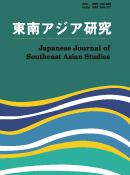Volume 3, Issue 2
Displaying 1-35 of 35 articles from this issue
- |<
- <
- 1
- >
- >|
Report from the Director
-
Article type: Report from the Director
1965Volume 3Issue 2 Pages 1
Published: September 30, 1965
Released on J-STAGE: July 05, 2019
Download PDF (160K)
Articles
-
1965Volume 3Issue 2 Pages 2-6
Published: September 30, 1965
Released on J-STAGE: July 05, 2019
Download PDF (499K) -
1965Volume 3Issue 2 Pages 7-35
Published: September 30, 1965
Released on J-STAGE: July 05, 2019
Download PDF (2596K) -
1965Volume 3Issue 2 Pages 36-46
Published: September 30, 1965
Released on J-STAGE: July 05, 2019
Download PDF (945K) -
1965Volume 3Issue 2 Pages 47-61
Published: September 30, 1965
Released on J-STAGE: July 05, 2019
Download PDF (1000K) -
1965Volume 3Issue 2 Pages 62-73
Published: September 30, 1965
Released on J-STAGE: July 05, 2019
Download PDF (1736K)
Reports
-
1965Volume 3Issue 2 Pages 74-81
Published: September 30, 1965
Released on J-STAGE: July 05, 2019
Download PDF (1020K) -
1965Volume 3Issue 2 Pages 82-85
Published: September 30, 1965
Released on J-STAGE: July 05, 2019
Download PDF (486K) -
1965Volume 3Issue 2 Pages 86-87
Published: September 30, 1965
Released on J-STAGE: July 05, 2019
Download PDF (288K) -
1965Volume 3Issue 2 Pages 88-92
Published: September 30, 1965
Released on J-STAGE: July 05, 2019
Download PDF (623K) -
1965Volume 3Issue 2 Pages 93-97
Published: September 30, 1965
Released on J-STAGE: July 05, 2019
Download PDF (566K) -
1965Volume 3Issue 2 Pages 98-106
Published: September 30, 1965
Released on J-STAGE: July 05, 2019
Download PDF (1276K) -
1965Volume 3Issue 2 Pages 107-110
Published: September 30, 1965
Released on J-STAGE: July 05, 2019
Download PDF (471K)
News from the Field
-
1965Volume 3Issue 2 Pages 111-115
Published: September 30, 1965
Released on J-STAGE: July 05, 2019
Download PDF (998K) -
1965Volume 3Issue 2 Pages 116-118
Published: September 30, 1965
Released on J-STAGE: July 05, 2019
Download PDF (647K) -
1965Volume 3Issue 2 Pages 119-123
Published: September 30, 1965
Released on J-STAGE: July 05, 2019
Download PDF (837K) -
1965Volume 3Issue 2 Pages 124-128
Published: September 30, 1965
Released on J-STAGE: July 05, 2019
Download PDF (709K)
Annotated Bibliography
-
1965Volume 3Issue 2 Pages 129-141
Published: September 30, 1965
Released on J-STAGE: July 05, 2019
Download PDF (1313K)
Book Reviews
-
1965Volume 3Issue 2 Pages 142
Published: September 30, 1965
Released on J-STAGE: July 05, 2019
Download PDF (168K) -
1965Volume 3Issue 2 Pages 143
Published: September 30, 1965
Released on J-STAGE: July 05, 2019
Download PDF (186K) -
1965Volume 3Issue 2 Pages 143-144
Published: September 30, 1965
Released on J-STAGE: July 05, 2019
Download PDF (318K) -
1965Volume 3Issue 2 Pages 144-145
Published: September 30, 1965
Released on J-STAGE: July 05, 2019
Download PDF (322K) -
1965Volume 3Issue 2 Pages 145-146
Published: September 30, 1965
Released on J-STAGE: July 05, 2019
Download PDF (326K) -
1965Volume 3Issue 2 Pages 146
Published: September 30, 1965
Released on J-STAGE: July 05, 2019
Download PDF (187K) -
1965Volume 3Issue 2 Pages 146-147
Published: September 30, 1965
Released on J-STAGE: July 05, 2019
Download PDF (319K) -
1965Volume 3Issue 2 Pages 147
Published: September 30, 1965
Released on J-STAGE: July 05, 2019
Download PDF (178K) -
1965Volume 3Issue 2 Pages 147-148
Published: September 30, 1965
Released on J-STAGE: July 05, 2019
Download PDF (305K) -
1965Volume 3Issue 2 Pages 148
Published: September 30, 1965
Released on J-STAGE: July 05, 2019
Download PDF (174K) -
1965Volume 3Issue 2 Pages 148-149
Published: September 30, 1965
Released on J-STAGE: July 05, 2019
Download PDF (297K) -
1965Volume 3Issue 2 Pages 149
Published: September 30, 1965
Released on J-STAGE: July 05, 2019
Download PDF (171K) -
1965Volume 3Issue 2 Pages 149-150
Published: September 30, 1965
Released on J-STAGE: July 05, 2019
Download PDF (309K) -
1965Volume 3Issue 2 Pages 150-151
Published: September 30, 1965
Released on J-STAGE: July 05, 2019
Download PDF (311K) -
1965Volume 3Issue 2 Pages 151
Published: September 30, 1965
Released on J-STAGE: July 05, 2019
Download PDF (179K)
News from the Center for Southeast Asian Studies
-
Article type: Appendix
1965Volume 3Issue 2 Pages 152-158
Published: September 30, 1965
Released on J-STAGE: July 05, 2019
Download PDF (420K)
Postscript
-
Article type: Appendix
1965Volume 3Issue 2 Pages 159
Published: September 30, 1965
Released on J-STAGE: July 05, 2019
Download PDF (78K)
- |<
- <
- 1
- >
- >|
